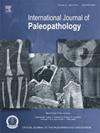拉多姆(波兰)18/19 世纪人口的牙齿畸形特征。
IF 1.5
3区 地球科学
Q3 PALEONTOLOGY
引用次数: 0
摘要
研究目的研究的目的是评估从 18 世纪至今造成错颌畸形的因素的非同步性:方法:根据发现的错颌畸形类型对头骨进行分组:畸形头骨:男性46个;畸形头骨:女性28个:方法:根据发现的错颌畸形类型对头骨进行分组:i)前后咬合(骨骼等级 I/II/III);ii)横向咬合(交叉咬合/剪刀式咬合);iii)纵向咬合(开放式咬合/深咬合):研究组中有 14%(10/74)的人咬合正常。其余病例(64/74,86%)均为错颌畸形。在研究组中,第一类咬合不正的诊断率最高(53%),第三类咬合不正的诊断率最低(8%):在拉多姆人群中观察到的角分级频率顺序(I > II > III)表明,错颌畸形与当代人群相似。在拉多姆的人群中,发现 II 类缺陷的频率高于 III 类缺陷,这与其他当代欧洲人群相似:研究表明,在过去四个世纪中,在波兰人口中产生不同类型错颌畸形的因素具有非同步性,即使这些因素无法确定:局限性:这项研究的主要局限性在于样本量相对较小:今后的研究应评估拉多姆以及波兰和欧洲其他地区老年人口的错颌畸形情况。本文章由计算机程序翻译,如有差异,请以英文原文为准。
Characteristics of dental malocclusion in a 18th/19th century population from Radom (Poland)
Objective
The aim of the study was to assess the diachronicity of factors that produce malocclusion from the 18th century to the present.
Materials
A total of 74 adult individuals Radom (Poland) of both sexes were examined (males: 46, females: 28).
Methods
The skulls were grouped according to the type of malocclusion found: i) anterio-posterior (skeletal Class I/II/III), ii) transverse (cross bite/scissor bite), and iii) vertical (open bite/deep bite).
Results
Normal bites were recorded in 14 % (10/74) of the study group. Malocclusion was observed in the remaining cases (64/74, 86 %). Class I was diagnosed most often (53 %), and Class III (8 %) was the least common in the study group.
Conclusions
The observed order of frequency of Angle’s Classes (I > II > III) in the population from Radom indicates malocclusion was similar to that of the contemporary population. In the population from Radom, similar to other contemporary European populations, Class II defects were found at a higher frequency than Class III defects.
Significance
The research demonstrates the diachronic nature of the factors that produce different types of malocclusion in Polish populations over the past four centuries, even if these factors cannot be identified.
Limitation
The main limitation of this research is the relatively small sample size.
Suggestions for further research
Future studies should evaluate malocclusion in older populations from Radom and other areas of Poland and Europe.
求助全文
通过发布文献求助,成功后即可免费获取论文全文。
去求助
来源期刊

International Journal of Paleopathology
PALEONTOLOGY-PATHOLOGY
CiteScore
2.90
自引率
25.00%
发文量
43
期刊介绍:
Paleopathology is the study and application of methods and techniques for investigating diseases and related conditions from skeletal and soft tissue remains. The International Journal of Paleopathology (IJPP) will publish original and significant articles on human and animal (including hominids) disease, based upon the study of physical remains, including osseous, dental, and preserved soft tissues at a range of methodological levels, from direct observation to molecular, chemical, histological and radiographic analysis. Discussion of ways in which these methods can be applied to the reconstruction of health, disease and life histories in the past is central to the discipline, so the journal would also encourage papers covering interpretive and theoretical issues, and those that place the study of disease at the centre of a bioarchaeological or biocultural approach. Papers dealing with historical evidence relating to disease in the past (rather than history of medicine) will also be published. The journal will also accept significant studies that applied previously developed techniques to new materials, setting the research in the context of current debates on past human and animal health.
 求助内容:
求助内容: 应助结果提醒方式:
应助结果提醒方式:


